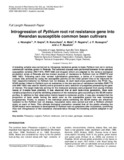| dc.description.abstract | A breeding scheme was carried out to introgress resistance genes to bean Pythium root rot in various
commercial varieties grown in Rwanda. The achieved crosses were performed between three selected
susceptible varieties (R617-97A, RWR 1668 and Urugezi) which are adapted to the various ecological
production zones of Rwanda and two known sources of resistance to Pythium root rot (RWR719 and
AND 1062). Following each inter varietal hybridization generation, a series of 4 successive back crosses was achieved by using the susceptible parents as the initial parent lines to be improved for
their respective behavior to Pythium root rot disease. At each back-cross generation, the PYAA 19800
SCAR marker linked to Pythium root rot resistance in the two sources of resistance (varieties RWR 719
and AND 1062) was used to identify and to proceed to early selection of progenies possessing the gene
of interest. The target materials serving for the molecular analyses were prepared from young trifoliate
leaves of 2-weeks bean plantlets. It was observed that at each back-cross generation, there were
variable proportions of plants exhibiting presence of the resistance gene according to the SCAR marker
profiles. In addition to that observation mainly based to molecular profile, it was also revealed that the
proportion of bean seeds having the same color as the susceptible parent line was increasing
progressively. Finally, to assess if the individual plants exhibiting the SCAR marker are effectively
resistant to the Pythium root rot disease, inoculation tests were carried out with a Pythium ultimum
strain on each of them. This ultimate biological evaluation revealed that all the plants showing the
SCAR marker were resistant to development of Pythium root rot symptoms after inoculation, confirming
thus real introgression of the resistance characteristics through the breeding scheme adopted in our
work | en_US |

